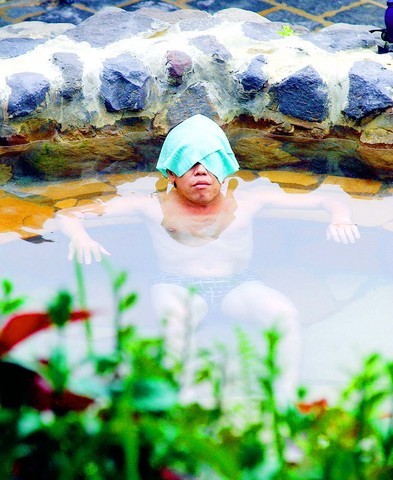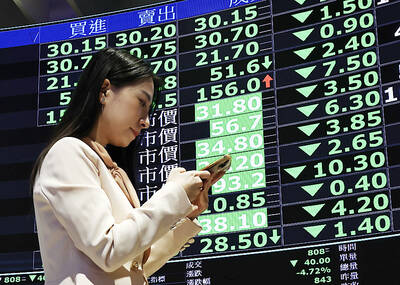With a towel wrapped around his head, Chen Jen greets his friends as he slips into a pool of hot water and hums his favorite song.
Like many men visiting this hot spring in Beitou (
Nostalgically, Chen closes his eyes and hums a song called "Yunojima elegy," about a man seeking comfort in a bathhouse after he is ditched by his lover.

PHOTO: AFP
"That was a Japanese song very popular more than half a century ago," 72-year-old Chen recalls as sweat drops down his face while steam with the smell of sulfur rises from the pool.
"At that time, it took only three cents to have a hot spring bath," he adds wistfully.
The spartan public bathrooms in Beitou are the most famous in Taiwan, where hot spring culture is more than a century old. Its development dates back to 1893 when a German businessman discovered hot springs there and set up a spa.
When Japan began its colonization of Taiwan two years later, the culture of hot springs started to spread across the island and during the 50-year occupation, Beitou flourished as the premiere spa destination.
Even so, housewives and children from outside the area were reluctant to stay in hot spring hotels.
"Beitou used to be a place for men only. They came here mainly for drinking and having sex while enjoying hot springs," says 46-year-old Yeh Su-hung, a Beitou resident.
But things have changed since the late 1990s, with Beitou emerging as a popular leisure spot for families.
"Time flies and everything has changed," says Chen, as he sits in the tub of 40oC water.
The pools are now surrounded by several luxurious high-rise hot spring hotels nestling on the foothills of the Tatun (
Windy Yang (
"Japan's onsen [hot spring] culture has had a far-reaching influence on the development of the local hot spring industry," she says, adding that it has become something of a heath fad in more recent times.
"I suffered from some injuries like tennis elbow and wrist strains, but these have greatly improved over the past five years," says Yeh, who pays just NT$40 for each stay of up to 150 minutes at his favorite Beitou spa.
"However, it only works if you do it regularly. I do it five days a week," he says.
A driving factor behind the gentrification of spas was the government's adoption of a five-day work week in 2000, says Chen Hui-tsung of the Hot Spring Tourism Association of Taiwan (中華民國溫泉觀光協會).
"With parents having more time, they now look for good places suitable for whole families. Parents would never consider taking their children to hot springs where sex services are available," he says.
Television programs about Japan's famous hot spring resorts are also fuelling the interests of leisure seekers and entrepreneurs.
"Spa and hot springs investors have found huge business opportunities from the changes [in the perception of hot springs]," Chen says.
The sector has attracted investment worth billions of dollars to construct some 150 large resorts, hotels and restaurants in the nation's 20 hot spring areas, he says. In Beitou alone, there are more than 20 hotels.
For those who prefer to soak in privacy rather than a communal public bath, there are luxury resorts in Beitou and places such as Wulai (
"Once they are here, our clients will definitely appreciate the value of our service," says Jesse Cheng (
The upscale resort has had an occupancy rate of around 70 percent since it opened in 2001, despite a price tag of NT$26,000 per night in one of its suites.
Private baths suit "Spa Lady" Yang who says she likes "nude bathing" because "it helps strip off the burden of daily living, and gives me a feeling like being in a mother's womb."
Unlike Japan, where hot spring tourists stay overnight or longer, most Taiwanese usually drop in for just an hour or two.
"That's because in Japan, hot springs are located in remote areas and it may take several hours to reach them. In Taiwan, hot spring areas are on Taipei's doorstep," the association's Chen says.

TARIFFS: The global ‘panic atmosphere remains strong,’ and foreign investors have continued to sell their holdings since the start of the year, the Ministry of Finance said The government yesterday authorized the activation of its NT$500 billion (US$15.15 billion) National Stabilization Fund (NSF) to prop up the local stock market after two days of sharp falls in reaction to US President Donald Trump’s new import tariffs. The Ministry of Finance said in a statement after the market close that the steering committee of the fund had been given the go-ahead to intervene in the market to bolster Taiwanese shares in a time of crisis. The fund has been authorized to use its assets “to carry out market stabilization tasks as appropriate to maintain the stability of Taiwan’s

STEEP DECLINE: Yesterday’s drop was the third-steepest in its history, the steepest being Monday’s drop in the wake of the tariff announcement on Wednesday last week Taiwanese stocks continued their heavy sell-off yesterday, as concerns over US tariffs and unwinding of leveraged bets weighed on the market. The benchmark TAIEX plunged 1,068.19 points, or 5.79 percent, to 17,391.76, notching the biggest drop among Asian peers as it hit a 15-month low. The decline came even after the government on late Tuesday authorized the NT$500 billion (US$15.2 billion) National Stabilization Fund (國安基金) to step in to buoy the market amid investors’ worries over tariffs imposed by US President Donald Trump. Yesterday’s decline was the third-steepest in its history, trailing only the declines of 2,065.87 points on Monday and

TARIFF CONCERNS: The chipmaker cited global uncertainty from US tariffs and a weakening economic outlook, but said its Singapore expansion remains on track Vanguard International Semiconductor Corp (世界先進), a foundry service provider specializing in producing power management and display driver chips, yesterday withdrew its full-year revenue projection of moderate growth for this year, as escalating US tariff tensions raised uncertainty and concern about a potential economic recession. The Hsinchu-based chipmaker in February said revenues this year would grow mildly from last year based on improving supply chain inventory levels and market demand. At the time, it also anticipated gradual quarter revenue growth. However, the US’ sweeping tariff policy has upended the industry’s supply chains and weakened economic prospects for the world economy, it said. “Now

Six years ago, LVMH’s billionaire CEO Bernard Arnault and US President Donald Trump cut the blue ribbon on a factory in rural Texas that would make designer handbags for Louis Vuitton, one of the world’s best-known luxury brands. However, since the high-profile opening, the factory has faced a host of problems limiting production, 11 former Louis Vuitton employees said. The site has consistently ranked among the worst-performing for Louis Vuitton globally, “significantly” underperforming other facilities, said three former Louis Vuitton workers and a senior industry source, who cited internal rankings shared with staff. The plant’s problems — which have not